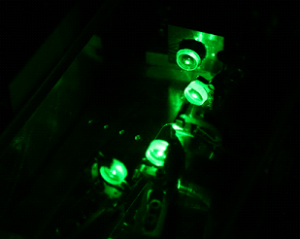Optomechanics and Quantum Measurments
SOME PUBLICATIONS
K. Makles, T. Antoni, A. G. Kuhn, S. Deléglise, T. Briant, P.-F. Cohadon, R. Braive, et al. “2D Photonic-Crystal Optomechanical Nanoresonator.”
Opt. Lett. 40 (2015)
X. Chen, C. Chardin, K. Makles, C. Caër, S. Chua, R. Braive, I. Robert-Philip, et al. 2016. “High-Reflectivity Si3N4 Photonic-Crystal Membranes for Optomechanics:”
Submitted (2016)
PEOPLE
Sheon Chua (postdoc)
Thibaut Jacqmin (staff scientist)
Samuel Deléglise (staff scientist)
Tristan Briant (staff scientist)
Antoine Heidmann (staff scientist)
Pierre François Cohadon (permanent)
Virgo interferometer-related activities
The LKB Virgo group is part of the “Optomechanics and Quantum Measurement” group. It is involved in the effort of the Quantum Noise Working Group to investigate the use of squeezed states of light to increase Advanced Virgo’s sensitivity. We are currently building a low-frequency squeezed light source and plan to inject its output into a 50-m long suspended optical cavity (the CALVA cavity at the Laboratoire de l’Accélérateur Linéaire in Orsay) to engineer frequency-dependent squeezing. This type of squeezing would be a pathway that allows us to lower quantum noise across the Advanced Virgo sensitivity band. This requires joint stable operation of a low-frequency squeezed source and of a suspended cavity with a bandwidth in the 100-Hz range, which is a tremendous technical challenge.
In addition, the LKB Virgo group also investigates classical radiation-pressure effects in the interferometer and possible strategies for their control. For instance, due to the high laser power operation, the coupling between internal vibration modes of the mirror substrates and transverse optical modes of the arm cavities was predicted to lead to dynamical instabilities under certain conditions, a phenomenon the LKB group has already demonstrated and investigated in its table-top optomechanical experiments. Such instabilities could prevent 2nd generation gravitational-wave interferometers to operate at their design optical power.
Gravitational waves have recently been observed from the merger of two black holes [A]. This is a result that confirms a major prediction of the Theory of General Relativity made by Albert Einstein in 1915, and opens a completely new window into the Cosmos. Members of the Optomechanics and Quantum Measurement team form the LKB Virgo group, part of the Virgo Collaboration, and contributed to this result. Our Virgo interferometer-related activities also include:
Link [A]: Observation of gravitational waves from a binary black hole merger, the LIGO Scientific Collaboration and the Virgo Collaboration. Physical Review Letters, 11 February 2016 http://link.aps.org/doi/10.1103/PhysRevLett.116.061102
3-mode instabilities in Advanced Gravitational Wave Detectors (PF)
The LKB Virgo group investigates classical radiation-pressure effects in the Advanced Virgo interferometer and possible strategies for their control.
For instance, due to the high laser power operation, the coupling between internal vibration modes of the mirror substrates and transverse optical modes of the arm cavities
was predicted to possibly lead to dynamical instabilities, a phenomenon the group has already demonstrated and investigated in table-top optomechanical experiments
(cite http://journals.aps.org/pra/cited-by/10.1103/PhysRevA.91.033832).
Such instabilities could prevent Advanced Virgo to operate at its full design optical power.
Squeezed light for Gravitational Wave Detectors
Squeezed light cavity
 Advanced gravitational-wave interferometers, such as Advanced Virgo, are expected to be operated at their design sensitivity within a couple of years. They should be limited by Quantum Radiation Pressure Noise at the lower side of their science frequency band (from 10 Hz to 50 Hz) and by Quantum Shot Noise at the higher side (above 200 Hz and up to 10 kHz). One pathway to reduce such quantum noise is to use squeezed states of light.
Advanced gravitational-wave interferometers, such as Advanced Virgo, are expected to be operated at their design sensitivity within a couple of years. They should be limited by Quantum Radiation Pressure Noise at the lower side of their science frequency band (from 10 Hz to 50 Hz) and by Quantum Shot Noise at the higher side (above 200 Hz and up to 10 kHz). One pathway to reduce such quantum noise is to use squeezed states of light.
We are involved in the effort to investigate the use of squeezed states of light to increase Advanced Virgo’s sensitivity. We are also currently building a low-frequency squeezed light source and plan to inject its output into a 50-m long suspended optical cavity (the CALVA cavity at the Laboratoire de l’Accélérateur Linéaire in Orsay) to engineer frequency-dependent squeezing. This particular type of squeezing would be a pathway that allows the lowering of quantum noise across the Advanced Virgo sensitivity band. This requires joint stable operation of a low-frequency squeezed source and of a suspended cavity with a bandwidth in the 100-Hz range, which is a tremendous technical challenge.
